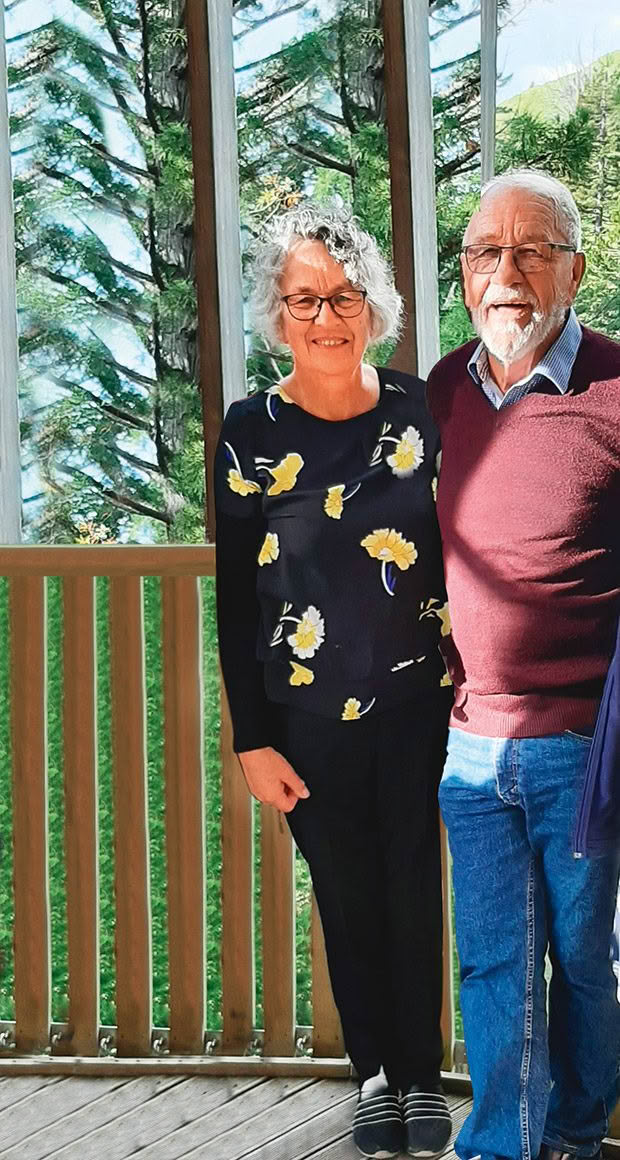This Glorit couple created a kiwi haven and bush walk on their 1300ha farm

One couple’s work in making a kiwi-safe habitat near the Kaipara Harbour has grown into a project to create an ecological corridor so north island brown kiwi can move safely from coast to coast.
Words: Kate Coughlan
Kevin and Gill Adshead looked from the 300-metre summit of Mount Auckland in the Atuanui Scenic Reserve on the southern shores of the Kaipara Harbour. It was 2005, and they were volunteer pest controllers helping Forest and Bird protect the Atuanui/Mount Auckland Scenic Reserve. Across the valley was their 1300-hectare farm at Glorit, near the Hoteo River estuary.
“Why don’t we do this on our own farm?” they wondered. The Adsheads’ farm had been in Gill’s family for five generations when she and Kevin took it over as a young married couple. They were always ecologically aware but hadn’t recognized the extent of pest damage to their pockets of remnant bush. Once they realized their trees were silently dying, they felt they had to act.
“It was horrible to see the pōhutukawa trees struggling, as the possums were so numerous,” says Gill. “They tend to select one tree as their favourite — maybe it has the sweetest taste – and they annihilate it by eating all the leaves until they kill the tree. Then they move onto the next one.”

“It is not just the trees that suffer,” says Kevin, “Because the trees have no leaves, there is no leaf fall, so no humus on the forest floor, no insects, no seedlings. Just rats.”
They took to predator control with a vengeance, training in traps and poisons, obtaining the required licences, attending pest-free workshops and spending their evenings studying pest and predator management. They started in 2006, and within a short time, they’d despatched 550 possums, a hefty number of rats and mustelids and harnessed further volunteers under the umbrella name of the Mataia Restoration Project. They watched in wonderment as their pōhutukawa trees began to regenerate, the forest floor became host to seedling nīkau and other species, and native birds returned.
An Auckland Council pest-free workshop opened their eyes to the “safe land” requirement into which translocated north island brown kiwi could be released. They applied themselves to a somewhat Herculean task of ensuring their patches of remnant bush were fenced, trapped and predator-free for kiwi. When the birds were released in 2013, Gill and Kevin were among the first farmers in the country to have had kiwi freed onto their private farmland. This achievement was recognized, with each awarded a Queen’s Service Medal for their tireless conservation efforts.
Did this see them rest on their laurels and take a break in their freshly flowering pōhutukawa? Not at all. They felt their lives had been enriched as much as the trees and birds and wondered how much more they could achieve. If dreams could come true, they saw north island brown kiwi strolling safely from coast to coast while poking around on a forest floor rich with diverse biological species and drinking from streams free of pollution.
The Forest Bridge Trust, established in 2014, aims to build that safe passage via connecting corridors of native bush, replanting stream banks and fencing off areas from livestock.
The Forest Bridge Trust is now a large organization primarily funded by Jobs for Nature, with Gill and Kevin playing an essential role as “enablers” — in the most beneficial way possible, of course. The goal is to create the kiwi-safe corridor between Mahurangi on the east coast and the Kaipara Harbour within the next five years and a 54,000-hectare central bridge connecting existing wildlife sanctuaries at Mataia Restoration Project on the Adshead farm to Tāwharanui Regional Park in the east.
Meanwhile, the Adsheads’ large-scale efforts, combined with their sheep and beef operation, have seen 400-hectares restored to native bushland with 7500 native trees planted annually and the opening of the Mataia Trail. The five-hour loop walk is open to day walkers and has accommodation.
Bookings essential. mataia.co.nz/the-trail
HOW TO CREATE EFFECTIVE CONSERVATION GROUPS
• Build from the grassroots up
• Create hubs of like-minded people who share a goal
• Don’t tell people what to do but ask what they want to happen and what they need to make it so
• Don’t take no for an answer — sometimes, it is easier to ask forgiveness than permission
• Start young — talk to schoolchildren
HOW TO HELP THE FOREST BRIDGE TRUST
Volunteers are vital to the achievement of the Forest Bridge Trust’s vision. It needs help with trap-line checking, wildlife monitoring and, on occasion, behind the scenes with jobs such as loading data, administration support and almost anything volunteers are skilled in.
Love this story? Subscribe now!
 This article first appeared in NZ Life & Leisure Magazine.
This article first appeared in NZ Life & Leisure Magazine.
